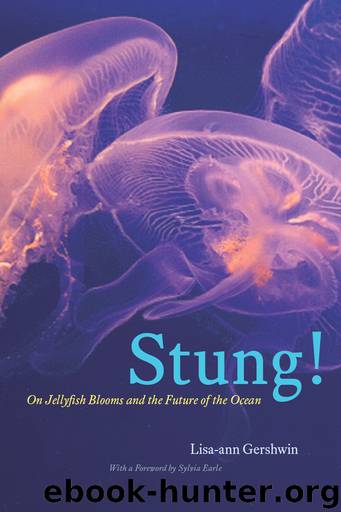Stung! On Jellyfish Blooms and the Future of the Ocean by Lisa-ann Gershwin

Author:Lisa-ann Gershwin [Gershwin, Lisa-ann]
Language: eng
Format: epub
Publisher: The University of Chicago Press
Published: 2013-06-16T16:00:00+00:00
[CHAPTER 9]
Biopollution: The Twelfth Plague
Invasive marine species are one of the four greatest threats to the world’s oceans! Unlike other forms of marine pollution, such as oil spills, where ameliorative action can be taken and from which the environment will eventually recover, the impacts of invasive marine species are most often irreversible! (Globallast.org, IMO 2012)
Jellyfish Threatening the Sydney Olympics (Australia, 2000)
Imagine being stung by a type of box jellyfish, not enough to kill you, but enough to distract you and slow you down. This is what the Olympic Committee was facing when Carybdea rastonii (see plate 2), a type of box jellyfish, was found swarming just weeks before the start of the Sydney Olympics in 2000. Carybdea cannot kill or make people sick, but its sting is sharp enough to bring tears to the eyes, and it was swarming in the exact location scheduled for the swimming portion of the triathlon events.
Understandably, there was great anxiety about even fractions of seconds being at stake due to distractions from stings, and of course the possibility of more severe reactions. Various management options were deemed unfeasible, such as protective clothing (unacceptable because it would slow down swim times), exclusion nets (extremely costly to net large sections of coastline), sweeping the area free of jellyfish (unreliable), and moving to a different area (not possible).
Luckily, just 1–2 weeks before the Opening Ceremony, the jellyfish bloom dissipated, and the triathlon events went off without a hitch.
. . .
The word “plague” conjures a feeling of dread and despair. Devastation. Helplessness. Its sources seem mysterious or beyond our control, and its effects seem unstoppable. The Bible listed 10 plagues that God inflicted on the Egyptians: the Nile turned to blood, frogs, insects, flies, sickness among animals, boils, hail, locusts, darkness, and death of the firstborn sons. The Black Death of 1348–1350 swept through Europe like, well, “like the plague,” and killed some 75–100 million people (about half of Europe’s population at the time). These plagues were limited in their geographic reach; nuisance species, in contrast, are not.
The statistics are mind-numbing and confronting:
• It is estimated that several thousand species are transported around the world each day on the shipping industry’s ballast water “floating zoos and botanical gardens” (Carlton and Geller 1993; NRC 1995; Carlton 2009, 39–40).
• Every hour an average of more than 2 million gallons of foreign plankton are released in US waters (Carlton 1995).
• In a 1993 report by the US Congress Office of Technology Assessment, it was found that a minimum of 4,542 species of foreign origin had established free-living populations in the United States; an analysis of the economic impact of just 79 of these species documented $97 billion in damages, in 1991 dollars (OTA 1993).
• The San Francisco Bay estuary has recorded 234 exotic species that have established populations, with at least an additional 125 species of obscure or uncertain origin (called “cryptogenic”) (Cohen and Carlton 1998).
• For the last 50 years, a new species has been introduced into the San Francisco Bay ecosystem every 14 weeks (Cohen and Carlton 1998).
Download
This site does not store any files on its server. We only index and link to content provided by other sites. Please contact the content providers to delete copyright contents if any and email us, we'll remove relevant links or contents immediately.
Sapiens: A Brief History of Humankind by Yuval Noah Harari(13997)
The Tidewater Tales by John Barth(12404)
Mastermind: How to Think Like Sherlock Holmes by Maria Konnikova(6944)
Do No Harm Stories of Life, Death and Brain Surgery by Henry Marsh(6690)
The Thirst by Nesbo Jo(6448)
Why We Sleep: Unlocking the Power of Sleep and Dreams by Matthew Walker(6366)
Life 3.0: Being Human in the Age of Artificial Intelligence by Tegmark Max(5198)
Sapiens by Yuval Noah Harari(5126)
The Longevity Diet by Valter Longo(4864)
The Body: A Guide for Occupants by Bill Bryson(4591)
The Rules Do Not Apply by Ariel Levy(4532)
The Immortal Life of Henrietta Lacks by Rebecca Skloot(4264)
Why We Sleep by Matthew Walker(4193)
Animal Frequency by Melissa Alvarez(4161)
Yoga Anatomy by Kaminoff Leslie(4108)
The Hacking of the American Mind by Robert H. Lustig(4094)
All Creatures Great and Small by James Herriot(3994)
Barron's AP Biology by Goldberg M.S. Deborah T(3949)
Double Down (Diary of a Wimpy Kid Book 11) by Jeff Kinney(3936)
